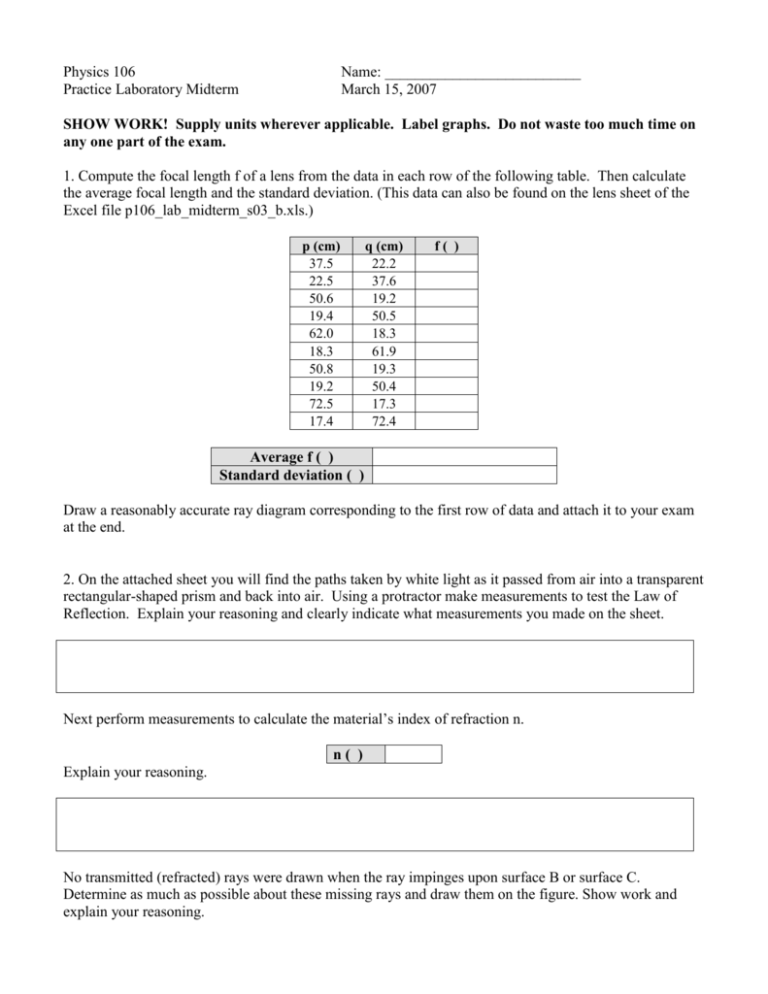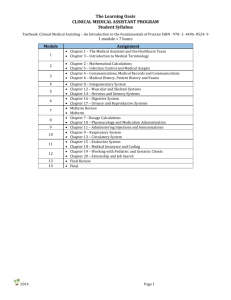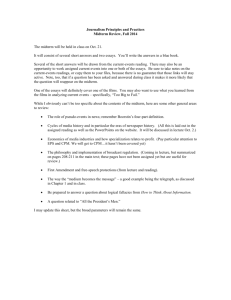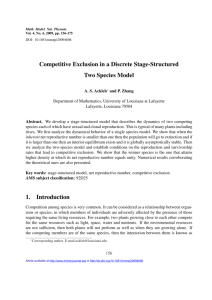Practice Lab Exam - La Salle University
advertisement

Physics 106 Practice Laboratory Midterm Name: __________________________ March 15, 2007 SHOW WORK! Supply units wherever applicable. Label graphs. Do not waste too much time on any one part of the exam. 1. Compute the focal length f of a lens from the data in each row of the following table. Then calculate the average focal length and the standard deviation. (This data can also be found on the lens sheet of the Excel file p106_lab_midterm_s03_b.xls.) p (cm) 37.5 22.5 50.6 19.4 62.0 18.3 50.8 19.2 72.5 17.4 q (cm) 22.2 37.6 19.2 50.5 18.3 61.9 19.3 50.4 17.3 72.4 f( ) Average f ( ) Standard deviation ( ) Draw a reasonably accurate ray diagram corresponding to the first row of data and attach it to your exam at the end. 2. On the attached sheet you will find the paths taken by white light as it passed from air into a transparent rectangular-shaped prism and back into air. Using a protractor make measurements to test the Law of Reflection. Explain your reasoning and clearly indicate what measurements you made on the sheet. Next perform measurements to calculate the material’s index of refraction n. n( ) Explain your reasoning. No transmitted (refracted) rays were drawn when the ray impinges upon surface B or surface C. Determine as much as possible about these missing rays and draw them on the figure. Show work and explain your reasoning. 3. A plunger tube has resonances at the following lengths. Determine the frequency of the sound that is driving the tube. Length (cm) 7.2 25.1 43.2 60.7 Explain your reasoning. Fit the envelope function for the data found on the beat sheet of the Excel file p106_lab_midterm_s03_a.xls to the formula y(t) = yeq + A cos( 2 t / T + ) Title it Beat Data (Smith) with your last name in place of Smith. Print it out. (Make sure the graph is highlighted when you print so that you do not print the data.) Enter your fit parameters into the following table. yeq ( ) A( ) T( ) ( ) The beat data above was obtained by having two distinct driving frequencies. The lower was 350 Hz. Estimate the higher frequency. Other frequency ( ) Explain your reasoning. 4. Standing wave patterns were observed at the following frequencies. The corresponding node-to-node distances were measured. Calculate the velocity for each row of data. (This data can also be found on the standing wave sheet of the Excel file p106_lab_midterm_s03_b.xls.) Frequency (Hz) 12 20 28 36 Node-to-node distance (cm) 112 69 50 37 Velocity ( ) Plot the node-to-node distance versus frequency and fit it to a power law. Title it Standing Wave Data (Smith). Compare your fit to what you should expect theoretically. There were some knots toward the end of the cord that were not untied when its length was measured. What effect would this have on the (F/)1/2 prediction of velocity? Explain. 5. The amplitude (maximum angle) of a pendulum was varied, and the period was measured. The resulting data follows. (This data can also be found on the pendulum sheet of the Excel file p106_lab_midterm_s03_b.xls.) Maximum Angle M (degrees) 5 10 15 20 25 30 35 40 45 50 55 60 65 70 75 Maximum Angle M (radians) Sin(M/2) Period (s) 0.800442 0.801534 0.803516 0.80618 0.809699 0.81398 0.819018 0.824991 0.831726 0.839315 0.847794 0.857044 0.867117 0.878072 0.889636 Fill in the missing columns. Note that third column is sin(M/2) NOT sin(M). Then plot the period versus Sin(M/2) and fit it to a polynomial of order two. Entitle it “Smith: Pendulum Data.” According to theory what should the coefficient of the square term be? You want a pendulum that has a period of 1.85 s determine the necessary mass, mass and amplitude and enter them into the table below. Mass ( ) Length ( ) Amplitude ( ) 6. A mass was hung vertically from a spring. The position versus time data was taken for several masses and fit to the form 2 y (t ) yeq A cos t 0 , T resulting in the following fit parameters Hanger + Mass (g) 50 100 150 200 250 yeq (m) A (m) T (s) 0 .692 .666 .645 .617 .593 0.0263 0.0256 0.0281 0.0335 0.0289 0.52 0.60 0.69 0.76 0.82 5.8 5.8 3.2 2.3 3.8 Determine the spring’s force constant graphically. Title it Spring Data (Smith) with your last name in place of Smith. Print it out. (Make sure the graph is highlighted when you print so that you do not print the data.) Spring’s force constant ( ) Suppose the 250-g mass above had been pulled down further before being released. Categorize the parameters as “will change”, “might change” or “won’t change” (within experimental error) and explain your choice. Parameter Will change, Might change or Won’t change yeq A T Explanation








